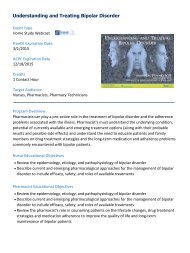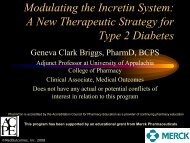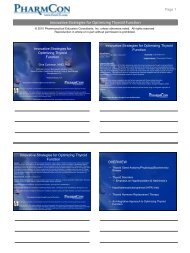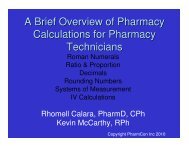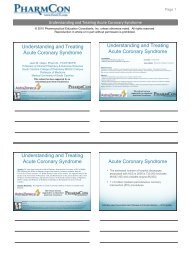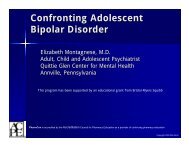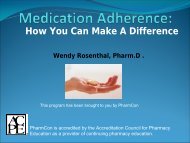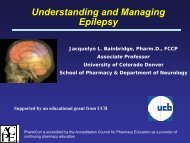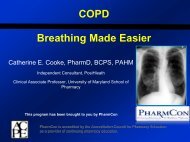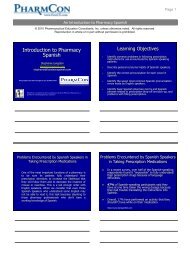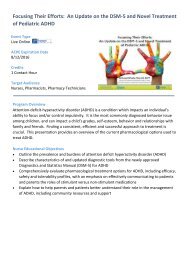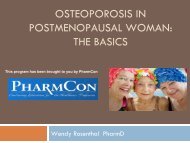Thyroid Monograph - FreeCE
Thyroid Monograph - FreeCE
Thyroid Monograph - FreeCE
Create successful ePaper yourself
Turn your PDF publications into a flip-book with our unique Google optimized e-Paper software.
Pharmacology in <strong>Thyroid</strong> Conditions<br />
Release Date: 3/13/2012<br />
Expiration Date: 3/13/2014<br />
FACULTY:<br />
Karla Torio, MD<br />
Practices General and Family Medicine and Cosmetic Surgery<br />
FACULTY AND ACCREDITOR DISCLOSURE<br />
STATEMENTS:<br />
Dr. Karla Torio has no actual or potential conflict of interest in relation to this program.<br />
ACCREDITATION STATEMENT:<br />
Pharmacy<br />
PharmCon Inc is accredited by the Accreditation Council for Pharmacy<br />
Education as a provider of continuing pharmacy education.<br />
Program No.: 0798-0000-12-024-H01-P<br />
Credits: 1 contact hour, 0.1 CEU<br />
Nursing<br />
Pharmaceutical Education Consultants, Inc. has been approved as a provider<br />
of continuing education for nurses by the Maryland Nurses Association which is<br />
accredited as an approver of continuing education in nursing by the American<br />
Nurses Credentialing Center’s Commission on Accreditation.<br />
Program No.: N-754<br />
Credits: 1 contact hour, 0.1 CEU
TARGET AUDIENCE:<br />
This accredited program is targeted nurses and pharmacists practicing in hospital and<br />
community pharmacies. Estimated time to complete this monograph and posttest is 60<br />
minutes.<br />
DISCLAIMER:<br />
PharmCon, Inc does not view the existence of relationships as an implication of bias or<br />
that the value of the material is decreased. The content of the activity was planned to be<br />
balanced and objective. Occasionally, authors may express opinions that represent<br />
their own viewpoint. Participants have an implied responsibility to use the newly<br />
acquired information to enhance patient outcomes and their own professional<br />
development. The information presented in this activity is not meant to serve as a<br />
guideline for patient or pharmacy management. Conclusions drawn by participants<br />
should be derived from objective analysis of scientific data presented from this<br />
monograph and other unrelated sources.<br />
Program Overview:<br />
To provide participants with an understanding of pharmacology in thyroid conditions.<br />
OBJECTIVES:<br />
After completing this program, participants will be able to:<br />
<br />
<br />
<br />
<br />
<br />
<br />
<br />
Explain the pathway of thyroid hormone synthesis as a basis in the<br />
understanding of the mechanism of action of the thyroid and anti-thyroid<br />
medications<br />
Explain the pathophysiology of thyroid problems<br />
List the different medications that are being used clinically for the treatment<br />
of thyroid conditions<br />
Describe and demonstrate the uses of the thyroid and anti-thyroid<br />
medications in the clinical setting<br />
Describe the mechanism of action of the drugs used in the treatment of<br />
thyroid problems<br />
Explain the adverse effects of the drugs used in treating thyroid problems<br />
Correlate the knowledge gained from this monograph in clinical practice
PHARMACOLOGY IN THYROID CONDITIONS<br />
I. Overview<br />
The thyroid gland is located on the anterior part of the neck, inferior to the thyroid<br />
cartilage or Adam’s apple. It consists of two lateral lobes connected by the<br />
isthmus which wrap around the trachea. The thyroid gland produces thyroid<br />
hormones which regulate metabolism and are important in regulating energy, the<br />
body’s use of vitamins and other hormones, and the growth and maturation of<br />
tissues. These hormones are thyroxime (T4), triiodothyronine (T3), and<br />
calcitonin.<br />
In order for the thyroid gland to function normally, iodide is required. This is<br />
absorbed from the gastrointestinal tract and 90% of it is stored in the thyroid<br />
gland and bound to thyroglobulin (Tg). 1 The transport of iodide into the thyroid<br />
follicular cells is regulated by thyroid stimulating hormone (TSH) from the pituitary<br />
gland. Once the iodide becomes oxidized and bound to Tg, it combines with<br />
tyrosine moieties to form iodotyrosinases in a single conformation called<br />
monoiodotyrosine (MIT) or coupled conformation called diiodotyrosine (DIT).<br />
When a molecule of MIT and a molecule of DIT couples, T3 is formed, while T4<br />
results in a coupling of two molecules of DIT. 2 T3 and T4 are both bound to Tg<br />
and are stored in the colloid in the center of the thyroid follicle. The majority of<br />
the released hormone is T4, which can be converted into T3 though deiodiination<br />
in the peripheral extrathyroidal tissues.<br />
The endocrine feedback system is composed of the hypothalamus, pituitary<br />
gland, and thyroid gland. This is called the hypothalamic-pituitary-thyroid axis<br />
and all of the components act together in the regulation of thyroid hormone<br />
production. Thyrotropin releasing hormone (TRH) is released from the<br />
hypothalamus and travels through the venous plexus of the pituitary gland,<br />
stimulating the release of thyroid stimulating hormone (TSH). The TSH then<br />
travels to the thyroid gland and stimulates thyroid gland production of thyroid<br />
hormones. 3<br />
TSH stimulates cell growth and differentiation of thyroid cells, iodine uptake, and<br />
release of T3 and T4 from Tg. It is the major regulator of the activity and<br />
production in the thyroid gland, and it has feedback mechanisms to prevent its<br />
over or underproduction. The release of TSH from the pituitary gland is<br />
stimulated by increased levels of thyrotropin releasing hormone (TRH) from the<br />
paraventricular nucleus of the hypothalamus and decreased levels of T3.<br />
Negative feedback through increased levels of thyroid hormones can also affect<br />
TSH by inhibiting its secretion.<br />
Torio-<strong>Thyroid</strong> Page 1
The thyroid gland also has its own intrinsic regulatory system. When there are<br />
excessive stores of dietary iodide, the thyroid gland inhibits further uptake of<br />
iodide into the follicular cells, hence controlling the intraglandular stores of thyroid<br />
hormones. The reverse occurs in cases where there is iodide deficiency.<br />
Physiologic Effects of <strong>Thyroid</strong> Hormones<br />
Metabolism: T3 and T4 stimulate metabolic activities in most tissues in<br />
the body, resulting in an increase in basal metabolic rate. This causes an<br />
increase in body heat production due to increased oxygen consumption<br />
and energy expenditure. Increased thyroid hormone levels stimulate fat<br />
mobilization, which results in increased fatty acid concentration in the<br />
plasma. Carbohydrate metabolism is also stimulated, causing enhanced<br />
activity of glucose entering the cells and increased gluconeogenesis and<br />
glyogenolysis which generate free glucose.<br />
Growth and Development: <strong>Thyroid</strong> hormones are essential for the<br />
normal growth and development in the fetal and neonatal brain, and in<br />
skeletal maturation. 4<br />
Calcium metabolism: Calcitonin is secreted by the C cells of<br />
parafollicular cells of the thyroid gland. It inhibits calcium absorption, thus<br />
lowering serum calcium levels. Secretion of calcitonin can be stimulated<br />
by increased levels of serum calcium, pentagastrin, and alcohol.<br />
II. Pathophysiology and Etiology<br />
<strong>Thyroid</strong> gland diseases can result in either an overproduction (hyperthyroidism)<br />
or underproduction (hypothyroidism) of thyroid hormones.<br />
A. Hypothyroidism<br />
Hypothyroidism is a common endocrine disorder mainly characterized by a<br />
deficiency of thyroid hormone due to insufficient amounts produced by the thyroid<br />
gland. It could also be due to inadequate secretion of either TRH from the<br />
hypothalamus or TSH from the pituitary, affecting the feedback loop, and<br />
therefore causing hypothyroidism.<br />
Normally, the thyroid gland releases 100 to 125 nmol of T4 and small amounts of<br />
T3 daily. T4, with a half-life of 7 to 10 days, is converted in the peripheral tissues<br />
to T3, which is the active form of thyroid hormone. Early on in the disease,<br />
compensatory mechanisms are at work in order to maintain adequate T3 levels.<br />
When there is a decreased production of T4, the pituitary gland compensates by<br />
Torio-<strong>Thyroid</strong> Page 2
increasing the secretion of TSH, which stimulates thyroid hypertrophy and<br />
hyperplasia and more T3 release.<br />
Primary hypothyroidism is caused by thyroid gland dysfunction and is the cause<br />
of more than 90% of hypothyroidism cases. One of the most common causes of<br />
hypothyroidism is Hashimoto’s thyroiditis. It is a condition wherein there is a<br />
defect in the production of thyroid hormone, leading to increased TSH, which in<br />
turn causes goiter or thyroid gland enlargement. This is the most common cause<br />
of hypothyroidism after 8 years of age. 5 Antithyroid antibodies that are present in<br />
patients with autoimmune diseases such as systemic lupus erythematosus,<br />
rheumatoid arthritis, diabetes, or Sjogren’s syndrome are being recognized by<br />
the body as foreign and causes a reaction, leading to the infiltration of the thyroid<br />
gland by lymphocytes and gradual and progressive destruction of thyroid<br />
tissues. 4 Another condition that could lead to hypothyroidism is a lack of thyroid<br />
tissue due to surgical removal or by radioactive destruction of thyroid tissue.<br />
Drug-induced hypothyroidism may be caused by certain medications such as<br />
lithium, para-aminosalicylate, sulfonamides, phenylbutazone, and amiodarone.<br />
Iodine deficiency or excess may also result in hypothyroidism because of the<br />
interference in iodide organification and thyroid hormone synthesis. 6 Congenital<br />
hypothyroidism, discovered during screening among newborns, occurs<br />
approximately once in every 4,000 live births. If left untreated, it can lead to<br />
growth failure and mental retardation. 7<br />
Secondary hypothyroidism occurs in cases of pituitary dysfunction, neoplasm, or<br />
infiltrative disease causing a deficiency of TSH, while tertiary hypothyroidism is<br />
seen in hypothalamic disease (eg, neoplasm, granuloma, or irradiation leading to<br />
TRH deficiency). 8<br />
B. Hyperthyroidism<br />
Hyperthyroidism is a hypermetabolic state caused by excess in the synthesis and<br />
secretion of thyroid hormone by the thyroid gland, which can be due to<br />
thyrotropic stimulus or autonomous function of thyroid tissue. 4,5 On the other<br />
hand, thyrotoxicosis is the clinical condition which is associated with elevated<br />
levels of free T4 and/ or free T3. The terms hyperthyroidism and thyrotoxicosis<br />
are oftentimes used interchangeably; however, hyperthyroidism pertains to the<br />
excess synthesis and release of thyroid hormone, while thyrotoxicosis is the<br />
clinical presentation resulting from it. Excess thyroid hormone can result in the<br />
an increase in the basal metabolic rate which is related to increased production<br />
of body heat and cardiovascular activity, such as increased heart rate,<br />
contractility, and vasodilation.<br />
Its prevalence is 1 in every 2000 adults. Hyperthyroidism is more common<br />
among females, affecting 2% of women and only 0.2% of men. 5,9<br />
Torio-<strong>Thyroid</strong> Page 3
The most common cause of hyperthyroidism, accounting for 60 to 80 percent of<br />
cases, is Graves’ disease. 10 This is an autoimmune disease caused by an<br />
antibody that binds to and activates the TSH receptor and stimulates the gland to<br />
synthesize and secrete excess thyroid hormone. Autonomous production of<br />
thyroid hormone occurs when thyrocytes function independently of TSH receptor<br />
activation, which could result from a benign thyroid adenoma or nodules from a<br />
toxic multinodular goiter. Toxic adenomas are common in younger patients and<br />
in iodine-deficient areas. 11 Toxic multinodular goiter (also known as Plummer<br />
disease) accounts for about 15 to 20 percent of hyperthyroidism cases and can<br />
be 10-fold more common in areas where there is iodine deficiency. 11 This also<br />
occurs more commonly among elderly patients with a long-standing goiter. 12<br />
<strong>Thyroid</strong>itis is an inflammatory condition that could cause transient excess<br />
secretion of thyroid hormones. This includes subacute thyroiditis (caused by a<br />
viral infection and may resolve within eight months), lymphocitic thyroiditis,<br />
postpartum thyroiditis (can occur in up to 5 to 10 percent of women 3 to 6 months<br />
following delivery), radiation-induced thyroiditis, and pharmacologic thyroiditis<br />
(precipitated by amiodarone). 13 Iodine-induced hyperthyroidism can sometimes<br />
occur after intake of excess iodine in the diet or exposure to radiographic<br />
contrast media, leading to an increase in the synthesis and release of thyroid<br />
hormone in individuals with iodine deficiency and in older patients with preexisting<br />
multi-nodular goiter. 14 Rarely, hyperthyroidism can be caused by tumors<br />
like metastatic thyroid cancer, an ovarian tumor called struma ovarii that<br />
produces thyroid hormone, and trophoblastic tumors that produce beta human<br />
chorionic gonadotropin (β-hCG) which could weakly activate TSH receptors.<br />
C. Other thyroid problems<br />
<strong>Thyroid</strong> nodules are common and can be seen in as many as 50 percent of all<br />
adults, although this condition is more common in women (6%) than in men<br />
(2%). 4 Most of these nodules are small and benign nodules, and only 5 percent<br />
of the cases represent malignancy.<br />
III. Clinical Features and Diagnosis<br />
Hypothyroidism causes a wide range of clinical presentations, from<br />
asymptomatic to myxedema coma, or multisystem organ failure. These<br />
symptoms can be due to derangements in the metabolic processes or<br />
myxedematous infiltration or accumulation of glucosaminoglycans in the tissue.<br />
In the heart, myxedematous changes can result in heart enlargement, pericardial<br />
effusion, and poor function (ie, decreased contractility, decreased cardiac<br />
output). Decreased thyroid hormones can also lead to increased levels of total<br />
cholesterol and low density lipoprotein (LDL) cholesterol in the bloodstream<br />
because of a change in metabolic clearance. An increase in insulin resistance<br />
may also result. In the gastrointestinal tract, decreased acid secretion,<br />
Torio-<strong>Thyroid</strong> Page 4
decreased intestinal transit, and gastric stasis can occur. There may also be<br />
menstrual irregularities, anovulation, delayed puberty, and infertility.<br />
The most common symptoms of hypothyroidism are the following: weight gain,<br />
cold intolerance, nonpitting edema in the skin of the hands and eyelids<br />
(myxedema), decreased sweating, fatigue or low energy levels, loss of appetite,<br />
dry skin, depression, muscle and joint pains, constipation, cognitive and memory<br />
impairment, weakness and numbness, fullness in the throat, and voice<br />
hoarseness. 5 In patients with Hashimoto’s thyroiditis, common complaints<br />
include painless thyroid enlargement with a feeling of fullness in the throat, low<br />
grade fever, sore throat, and easy fatigability. 15<br />
In severe cases of hypothyroidism, myxedema coma can occur particularly in<br />
undiagnosed or untreated patients. This is characterized by bradycardia,<br />
pericardial effusion, altered mental status, electrolyte imbalance (eg,<br />
hyponatremia, hypercarbia), and ascites. 16<br />
Classic symptoms of hyperthyroidism include weight loss despite a good<br />
appetite, palpitations, tremor, and heat intolerance. Other symptoms are the<br />
following: insomnia, fatigue, irritability, weakness, anxiety, dyspnea, nausea and<br />
vomiting. Common signs include tachycardia, hyperactivity, systolic<br />
hypertension, warm, moist, smooth skin, and a staring gaze with lid lag. In<br />
patients with Graves’ disease, the thyroid gland is usually enlarged with a smooth<br />
and lobulated contour. Patients with toxic nodular goiter, on the other hand, one<br />
or more discrete nodules may be appreciated.<br />
In Graves Ophthalmopathy, an autoimmune process is involved, affecting the<br />
orbital and periorbital tissues. It is caused by the deposition of<br />
glycosaminoglycans in the extraocular muscles and adipose and connective<br />
tissues of the retro-orbital area. This results in the activation of T cells, which<br />
has been thought to be mediated by the TSH receptor antigen. Clinical<br />
manifestations include proptosis, eyelid retraction, chemosis, edema in the<br />
periorbital area, and altered ocular movements.<br />
<strong>Thyroid</strong> storm is a rare presentation of hyperthyroidism which usually occurs in<br />
patients with untreated or undertreated hyperthyroidism and is precipitated by<br />
systemic insults (ie, trauma, surgery, severe infection, myocardial infarction, etc.)<br />
This is characterized by fever, severe tachycardia, delirium, vomiting, diarrhea,<br />
and dehydration. 17<br />
<strong>Thyroid</strong> nodules are usually detected incidentally on imaging procedures<br />
because most tend to be asymptomatic. The presence of compression<br />
symptoms (eg, pain or difficulty in swallowing due to esophageal compression,<br />
hemoptysis because of tracheal invasion, dysphonia due to encasement of the<br />
recurrent laryngeal nerve) or invasion into adjacent tissues may point to a<br />
Torio-<strong>Thyroid</strong> Page 5
malignant cause of the nodule. The most accurate test to confirm malignant<br />
disease is fine needle aspiration biopsy.<br />
IV. Medications<br />
A. Hypothyroidism<br />
In general, the goal of thyroid replacement therapy is to replace endogenous<br />
thyroid hormone production, avoid iatrogenic thyrotoxicosis, and treat systemic<br />
complications of severe hypothyroidism.<br />
1. Levothyroxine<br />
Levothyroxine is the treatment of choice because it is well absorbed and has a<br />
half-life of 7 days which allows daily dosing and steady levels of T3 and T4 being<br />
reached in approximately 6 weeks. 18 The starting dose should take into<br />
consideration factors such as age, preexisting coronary artery disease, and<br />
cardiac arrhythmias. A starting dose of 1.6 µg/kg/day in healthy patients is<br />
recommended, but in elderly patients or those with cardiac disease, it would be<br />
prudent to start at a dose of 25 µg to 50µg once daily. 18<br />
2. Liothyronine<br />
Liothyronine (L-triiodothyronine) is rarely used alone as thyroid hormone<br />
replacement because it can cause rapid increases in its concentration, which<br />
could be detrimental in elderly patients and those with cardiac disease. It can be<br />
used along with levothyroxine when levothyroxine alone does not provide relief of<br />
symptoms.<br />
3. <strong>Thyroid</strong> extract<br />
<strong>Thyroid</strong> extract or natural thyroid hormone is pig thyroid gland that has been<br />
dried and crushed in powder form. This is not a recommended thyroid hormone<br />
replacement because the amount of T4 and T3 can be variable and there can be<br />
an excess T3 in this preparation.<br />
B. Hyperthyroidism<br />
1. Propylthiouracil<br />
Antithyroid medications such as propylthiouracil and methimazole act<br />
predominantly by interfering with the organification of iodine, hence suppressing<br />
thyroid hormone levels. Because these agents block only the synthesis of new<br />
thyroid hormones, the stores of preexisting thyroid hormone within the thyroid<br />
Torio-<strong>Thyroid</strong> Page 6
gland must be exhausted first before they can be fully effective, which may take 3<br />
to 8 weeks in patients with Graves’ disease or toxic nodular goiter.<br />
Propylthiouracil (PTU) is a derivative of thiourea that inhibits extrathyroidal<br />
conversion of T4 to T3 and is preferred for pregnant women with hyperthyroidism<br />
because it does not cross the placental barrier as readily as methimazole. It is<br />
readily absorbed, with a serum half-life of 1 to 2 hours. Its duration of action is<br />
longer than the half-life and should be dosed every 6 to eight hours. Its starting<br />
dosage is 100 mg three times daily, with a maintaining dose of 100 to 200 mg a<br />
day. 19<br />
Patients undergoing treatment with antithyroid drugs should have their thyroid<br />
hormone levels reassessed every 3 to 12 weeks during dose titration to monitor<br />
for iatrogenic hypothyroidism. Common side effects include rashes, pruritus,<br />
joint pains, and fever. These can be treated symptomatically without<br />
discontinuing the medication, but if arthralgia occurs, it should be discontinued<br />
because it can be a precursor of a more serious polyarthritis syndrome. 19<br />
Agranulocytosis is the most serious complication and may occur in 0.1 to 0.5<br />
percent of patients being given antithyroid medications. 19 The risk is higher in<br />
20, 21, 22<br />
those taking propylthiouracil within the first few months of therapy.<br />
2. Methimazole<br />
Methimazole blocks the oxidation of iodine in the thyroid gland. It is the drug of<br />
choice in nonpregnant patients because of its affordable cost, longer half-life, and<br />
lower risk of hematologic adverse effects. It can be taken as a single daily dose,<br />
improving patients’ compliance to the medication. The starting dose is 15 to 30<br />
mg daily, which can be given along with a beta blocker. If the patient becomes<br />
clinically and biochemically euthyroid after one year of medication intake,<br />
methimazole can be discontinued. Relapse may occur, and is generally seen<br />
within a year of discontinuing the medication. If there is relapse, antithyroid<br />
therapy can be restarted and other options such as radioactive iodine or surgery<br />
is considered. 21<br />
3. Iodide<br />
Iodides block the extrathyroidal conversion of T4 to T3 and inhibit release of<br />
thyroid hormone. It is principally used as adjunctive therapy before emergency<br />
thyroid surgery, to reduce vascularity of the thyroid gland before surgery, and in<br />
failed therapy with beta blockers. 21 These are not used in the routine treatment<br />
of hyperthyroidism because it tends to paradoxically increase hormone release<br />
with chronic use. Organic iodide radiographic contrast agents such as iopanoic<br />
acid or ipodate sodium are more commonly used than inorganic iodides (eg,<br />
potassium iodide). Iopanoic acid causes rapid and significant inhibition of<br />
peripheral conversion of T4 to T3 and quickly reduces T3 levels. Potassium<br />
Torio-<strong>Thyroid</strong> Page 7
iodide (Lugol solution) contains 8 mg of iodide per drop, and is used for the<br />
treatment of thyroid storm for 10 to 14 days prior to thyroidectomy.<br />
4. Beta-adrenergic receptor blockers<br />
Beta blockers help to promptly alleviate the sympathomimetic manifestations of<br />
hyperthyroidism (eg, palpitations, anxiety, tremors, and heat intolerance)<br />
regardless of its underlying cause. In patients with cardiac arrhythmias like sinus<br />
tachycardia or atrial fibrillation with a rapid ventricular response rate, beta<br />
blockers can function to control the heart rate. Propanolol, a nonselective beta<br />
blocker, is preferred because of its direct effect on hypermetabolism and is most<br />
commonly used, although other beta blockers can be given. 23 Propanolol also<br />
partially inhibits conversion of T4 to T3 in the peripheral tissues. 4<br />
may be the only treatment required in patients with transient forms of<br />
hyperthyroidism, however, in patients with more sustained forms of<br />
Beta blockers<br />
hyperthyroidism (ie, Graves’ disease, toxic nodular goiter), definitive treatment is<br />
10, 20, 21, 24<br />
necessary.<br />
Propanolol dose can start at 20 to 40 mg every 8 hours and be increased<br />
progressively up to a maximum daily dose of 240 mg until symptoms are<br />
controlled. Longer-acting beta blockers such as metoprolol and atenolol can also<br />
be used. In cases where a short-acting parenteral agent is needed, Esmolol can<br />
be administered. Beta blockers should be used with caution in patients with a<br />
history of heart disease, obstructive pulmonary disease, asthma, or Raynaud’s<br />
phenomenon.<br />
5. Radioactive iodine therapy<br />
Radioactive iodine causes selective uptake and concentration in thyrocytes.<br />
Following oral administration, it destroys thyroid tissue, thereby controlling<br />
hyperthyroidism effectively. This is the treatment of choice for the majority of<br />
patients with Graves’ disease and toxic nodular goiter. High dose radioactive<br />
iodine therapy is recommended in elderly patients, those with preexisting cardiac<br />
disease, and patients with toxic nodular goiter or toxic adenomas. 25<br />
Its main adverse effect is the development of postablative hypothyroidism, which<br />
is more commonly seen in patients with Graves’ disease. Lifelong monitoring of<br />
thyroid hormone levels is necessary because patients develop this complication<br />
at a rate of 3% annually. Another side effect is the transient worsening of<br />
hyperthyroidism during the first month of treatment due to radiation thyroiditis.<br />
Opthalmopathy may develop or exacerbate in 15 percent of patients with Graves’<br />
26, 27<br />
disease, especially in those who smoke cigarettes. Lower dose radioactive<br />
iodine or prednisone can be used in those patients to reduce the risk of<br />
ophthalmopathy. 28<br />
Torio-<strong>Thyroid</strong> Page 8
Radioactive iodine is contraindicated in pregnant or lactating women because it<br />
can readily cross the placenta barrier and can be excreted into milk. This can<br />
lead to an ablative effect to the infant’s thyroid gland resulting in hypothyroidism.<br />
Torio-<strong>Thyroid</strong> Page 9
REFERENCES:<br />
1 Brent GA: The molecular basis of thyroid hormone action. N Engl J Med.1994;<br />
331:847-853.<br />
2 Spitzweg C, Heufelder AE, Morris JC: <strong>Thyroid</strong> iodine transport. <strong>Thyroid</strong>. 2000;<br />
10:321-330.<br />
3 Townsend C et al. Sabiston Textbook of Surgery. 18 th ed. St Louis, MO: WB<br />
Saunders, 2007.<br />
4 Goldman L et al. Goldman’s Cecil Medicine. 24 th ed. St Louis, MO: WB<br />
Saunders, 2011.<br />
5 Ferri, F. Ferri’s Clinical Advisor 2012. 1 st ed. Missouri: Mosby Inc, Elsevier<br />
Health Sciences Division, 2011.<br />
6 Woeber KA. Iodine and thyroid disease. Med Clin North Am. Jan 1991;<br />
75(1):169-178.<br />
7 Nebesio TD, McKenna MP, Nabhan ZM, et al. Newborn Screening Results in<br />
Children with Central Hypothyroidism. J Pediatr. Mar 10 2010.<br />
8 Yamada M, Mori M. Mechanisms related to the pathophysiology and<br />
management of central hypothyroidism. Nat Clin Pract Endocrinol Metab. Dec<br />
2008;4(12):683-94.<br />
9 Turnbridge WM, Evered DC, Hall R, Appleton D, Brewis M, Clark F, et al. The<br />
spectrum of thyroid disease in a community: The Whickham survey. Clin<br />
Endocrinol (Oxf). 1977;7:481–93.<br />
10 Weetman AP. Graves’ disease. N Engl J Med. 2000;343:1236–48.<br />
11 Corvilain B, Dumont JF, Vassart G. Toxic adenoma and toxic multinodular<br />
goiter. In: Werner SC, Ingbar SH, Braverman LE, Utiger RD, eds. Werner &<br />
Ingbar’s the thyroid: a fundamental and clinical text. 8th ed. Philadelphia:<br />
Lippincott Williams & Wilkins, 2000:564–72.<br />
12 Hyperthyroidism: Diagnosis and Treatment. Jeri Reid MD, Stephen Wheeler<br />
MD. American Family Physician. Vol 72, Issue 4 (August 2005).<br />
13 Slatosky J, Shipton B, Wahba H. <strong>Thyroid</strong>itis: differential diagnosis and<br />
management [published correction appears in Am Fam Physician 2000;62:318].<br />
Am Fam Physician. 2000;61:1047–52.<br />
14 Trivalle C, Doucet J, Chassagne P, Landrin I, Kadri N, Menard JF, et al.<br />
Differences in the signs and symptoms of hyperthyroidism in older and younger<br />
patients. J Am Geriatr Soc. 1996;44:50–3.<br />
15 Eskes SA, Endert E, Fliers E, et al. Prevalence of Growth Hormone Deficiency<br />
in Hashimoto's <strong>Thyroid</strong>itis. J Clin Endocrinol Metab. Mar 12 2010.<br />
16 Wartofsky L. Endocrinol Metab Clin North Am. Dec 2006; 35(4): 687-98, vii-viii]<br />
17 Nayak B, Burman K. Thyrotoxicosis and <strong>Thyroid</strong> Storm. Endocrinology and<br />
Metabolism Clinics. December 2006. 35(4): 663-86, vii.<br />
18 Fish L.H., Schwartz H.L., Cavanaugh J., et al: Replacement dose, metabolism,<br />
and bioavailability of levothyroxine in the treatment of hypothyroidism: role of<br />
triiodothyronine in pituitary feedback in humans. N Engl J Med. 1987. 316. 764-<br />
770.<br />
19 Cooper DS. Antithyroid drugs. N Engl J Med. 2005;352:905–17.<br />
Torio-<strong>Thyroid</strong> Page 10
20 Fitzgerald PA, Endocrinology. In: Tierny LM, McPhee SJ, Papadakis MA, eds.<br />
Current medical diagnosis and treatment. 44th ed. New York: McGraw-Hill,<br />
2005:1102–10.<br />
21 Woeber KA. Update on the management of hyperthyroidism and<br />
hypothyroidism. Arch Intern Med. 2000;160:1067–71.<br />
22 Harper MB, Mayeaux EJ Jr. <strong>Thyroid</strong> disease. In: Taylor RB. Family medicine:<br />
principles and practice. 6th ed. New York: Springer, 2003:1042–52.<br />
23 Jansson S, Lie-Karlsen K, Stenqvist O, Korner U, Lundholm K, Tisell LE.<br />
Oxygen consumption in patients with hyperthyroidism before and after treatment<br />
with beta-blockade versus thyrostatic treatment: a prospective randomized study.<br />
Ann Surg. 2001;233:60–4.<br />
24 American Academy of Clinical Endocrinologists. American Association of<br />
Clinical Endocrinologists medical guidelines for clinical practice for the evaluation<br />
and treatment of hyperthyroidism and hypothyroidism. Endocr Pract. 2002;<br />
8:457–69.<br />
25 Allahabadia A, Daykin J, Sheppard MC, Gough SC, Franklyn JA. Radio-iodine<br />
treatment of hyperthyroidism-prognostic factors for outcome. J Clin Endocrinol<br />
Metab. 2001;86:3611–7.<br />
26 Ginsberg J. Diagnosis and management of Graves’ disease. CMAJ. 2003;<br />
168:575–85.<br />
27 Bartalena L, Marcocci C, Bogazzi F, Manetti L, Tanda ML, Dell’Unto E, et al.<br />
Relation between therapy for hyperthyroidism and the course of Graves’<br />
ophthalmopathy. N Engl J Med. 1998;338:73–8.<br />
28 Devdhar M, Ousman Y, Burman K. Hypothyroidism. Endocrinology and<br />
Metabolism Clinics. September 2007; 36(3): 595-615, v.<br />
Torio-<strong>Thyroid</strong> Page 11



